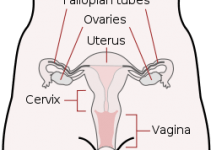Women have many ways to check if they are ovulating nowadays. You could use technology tools to help if you are trying to get pregnant, chart basal body temperature daily, check cervical mucus or buy one of the OTC ovulation predictor kits to know when an LH surge is approaching or tracking software to monitor your ovulation.
However, there are also some free, old age, and simple techniques that you can use to manually check your cervix position for ovulation signs. Below, we will look at how to check your cervix position for signs of ovulation.
First, you should know that your cervical position is a secondary, optional sign of fertility. It will provide the same information as your cervical fluid or the presence of estrogen, so it’s not really important if you have clear signs of cervical fluid.
Some women check their cervix position for the purpose of cross-checking or whenever their cervical fluid findings are not clear.
Although this sign of fertility is regarded as optional, you can get some useful information about your fertility state when you do this type of checking.
Cervical Position Changes
These are some of the changes that you might see in the texture and position of your cervix during your cycle:
When you are close to ovulation, a good sign would be if your cervix is high and feels soft, almost like your lips. Aside from that, you might or might not notice that it has a more open feel. The cervix usually feels wet, open, and higher during ovulation.
Your cervix might feel drier and firm up after ovulation. It will feel more closed-up and lower as well. There will be no egg discharge, so your cervix is going to be closed for most of your cycle.
This is something to keep in mind to avoid getting discouraged if you notice that your cervix feels closed most of the time.
Your cervix will become firm, low, closed, hard, and easy for you to feel early during your cycle, just after and during menstruation and before the peak of fertility when the estrogen level declines. When your fertility increases, your cervix will lift, straighten and become higher, more open and softer.
It is important to note that these cervical changes will make your cervix friendlier to sperm so that they can go into your reproductive tract and into the fallopian tubes to fertilize an egg.
How to Check Your Cervix Position for Signs of Ovulation
It will take some practice for you to check the cervical position, and then you’ll start to see signs of the changes throughout your monthly cycle.
A very good time for you to try would be after a shower or bath.
You should ensure that your hands are washed really well before checking. Your nails must also be trimmed to avoid discomfort. Another thing to do beforehand is to make sure that your bladder is empty.

When you are ready to start, you can sit on the toilet or squat or stand with one leg upon the edge of your bathtub. You should use the position that you choose for each check.
After getting into position, you should insert one or maybe two fingers gently inside the vagina in order feel for your cervix.
Doing manual checks on your cervix will be a good way for you to get familiar with your body and the way it should feel. Although this is a fairly low tech method, it could be a good indicator as to whether you are ovulating or not.
While checking the cervix position, you would still need to look out for other signs of ovulation such as basal body temperature and cervical mucus to ensure that you are not missing your ovulation whilst learning what the cervix feels like. Aside from that, if you are trying to conceive it’s okay to use one of the ovulation predictor kits.
At this point, it’s worth mentioning that it will not be really necessary for you to check your cervix if the process does not feel comfortable or you are finding it hard to observe the changes and it is easy for you to observe the cervical fluid.
Once you know how to check your cervix position for signs of ovulation, it will be easy for you to see changes during the month as well as to identify your most fertile period.
It will help you to find out when you are about to ovulate and can indicate if you are pregnant or not. If you’ve been tracking your ovulation and monitoring the cervical position and you are still not pregnant, you should visit a fertility doctor.
This is especially true if you are under 35 years old and have been trying to get pregnant for a year after engaging in well-timed sexual intercourse or you are over 35 years old and have been trying for about six months.




Good day, my name is Doris, my period came out on 1st of September and ended on 3rd and on 27th of September my period came out again….and ended 29….I had sex on the 30th pls is it possible I got pregant and wat cycle are mine..?
Hello Doris, see below link: https://womanjunction.com/
Also take PT 7 days after missed period.
Good Evening Ms. Lady , I Was Wondering If I will Still Get My Period ? Last Month My Period Came On Twice Beginning And Came Back On End 24 Or 25 I Think . This Month I Have Pasty Discharge So I Was Wondering Is My Period Off Balance ? Or Imma Get It On 24 Or 25 This Month ?
Hi there Warrenisha, you just have to hang around to see if it will come as we sometimes cannot predict these things. All the best.
Hi my name is Michelle
And I’ve had some breast discarded from my nipples trow the evening and all day today and my lower back hurts and my period was supposed to happen today and I haven’t got it yet and 3 nights ago I was throwing up and I’ve feel really nausea and I have morning sickness but I don’t get sick I my head hurts could I be pregnant or not and when should I take a pregnancy test if u don’t mind answer my question thanks
Hi Michelle, do you have regular periods always? If yes, then wait another three days and then take a pregnancy test. If no, please wait another week and then take the test.
my last period was on the 11th of june 2015, and i had sex on the 19tth and 26th of june my cycle is 28 days sumtyms 27day.is it possible to be pregnant?
I’m 39 and my husband is 45. Would you say it’s too late to try for a pregnancy? We have been trying 4 years now and to no avail …no baby. We’re heartbroken after trying all the techniques we’ve read online
I can’t say or estimate something like that through the web page. You have to consult with the expert for the family planning and not by reading instructions on teh random web pages. Internet can be a great source of the information but it can’t be your key solution for your problem.
I think that it is the best if you can sit down and talk with your husband and after that decide what you want to do together, and if possible to schedule an appointment with the specialist.
Ok, may be TMI but this seems the place to inquire about mine and my husbands worry. He had a romantic night as usual (nothing abnormal from any other night) however, my husband said my cervix felt closer. He couldn’t bring himself inside as far as normal and right after I felt very sore from my belly button to my pelvic bone in a straight line of course. Nothing to the sides and since sitting here about 30 minutes the pain as moved about half way down from where it started right after and continuing to right above the pelvic bone. So, clearly decreasing. He felt my cervix for me and said it was oddly low and hard. I am thirty, have one child through c-section, we are trying to conceive but we are unsure if this maybe, is a sign we already are. Any advise would help us. We just became unsure at this point and weren’t wanting to have to see a random doctor but we want to make sure this isn’t something to worry about while we are out of town. Thank you in advance!
Hi Ashley, I honestly suggest you see a doctor it could be anything so just see a doctor to make sure nothing is wrong.
My 1st day of my period was dec 30 and I’ve had unprotected sex jan 1, jan 3 and jan 9
… How posible is it for me to get pregnant and how long does sperm stay In the body?
im 40 and my husband is 52 we want to get pregnant we are disappointed
I’m 39 and my husband is 45. No luck after 4 years. Any suggestions or luck for you? ??